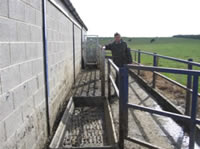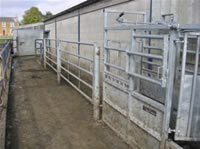Organisation:
Mark Barnes, Southfields Farm, Somerby, Melton Mowbray
Mark Barnes as a 125 cow dairy herd which he manages on his own with occasional help from family and a relief milker.
Introduction
The previous handling system involved moving cows across the yard into another building. The old system was originally designed for a much smaller herd and as numbers have expanded with more handling, either for herd health or statutory tests, handling cows became a time consuming task. It was also extremely difficult to sort out individual cows for specific tasks.
No specific major injuries were reported but there were a number of minor kicks and bruises that had become accepted as part of the process. A key concern was the poor floor and cows were slipping - greatly increasing the risk of injury to both the farmer and the animals.
What was done
The main objective was to have something simple that was fit for purpose given that the main tasks were handling of dairy cows either individually or as a herd. A simple gated race incorporating a footbath and crush were installed in a passageway outside the milking parlour. A shedding gate can be swung across the parlour exit to allow cows into or past the race.
Three key points were considered in consultation with the vet and observing other systems on farms:
- The length of the race needed to be sufficient to hold one side of the parlour – in this case 6 cows. Although there is room to extend the race to take 12 cows.
- The race had to be the right width to allow entry but to prevent cows turning – 700mm (about 28 inches) was used which accommodates the largest cows. But this may vary depending on the type of cattle handled.
- The side panels were set at 1500mm (5 feet) high which for dairy cows was considered sufficient to deter jumping.
An external parlour wall was utilised as one side of the race so the cost of metal gates and posts was about £200 (excluding labour). A basic general purpose crush suitable for most veterinary tasks on dairy cows was chosen as fit for purpose and cost approximately £1000. All metalwork is galvanised construction to give a reasonable working life.
Business benefits
A psychological barrier has now gone from handling cows and this encourages better management, for example carrying out Blue Tongue vaccinations and other whole herd health programmes. The time to carry out a whole herd task, TB testing for example, has decreased from 4 hours to around an hour. This is a much more effective use of time for both the farmer and the vet.
Having a suitable handling system is also better for the cows, reducing stress and the time they are held in the yard.
The only down side from the farmer's perspective was that it should have been done sooner.
Health and safety benefits
This is difficult to quantify in terms of injury reduction but the system is perceived to be safer by the farmer, vet and relief staff.
The most tangible benefit is in reduced stress when faced with a whole herd task such as TB testing or vaccination.
Further information
This case study shows a relatively simple and straightforward handling system for a medium sized dairy herd that is fit for purpose on this farm. Handling systems for other farms or beef and suckler cattle may need some additional features to make them suitable and effective.

